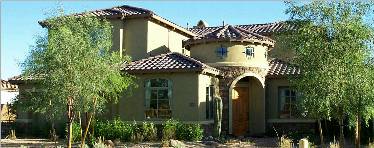|
Many
of today's homes include a fireplace. There are two types
of fireplaces found in the Phoenix area. The distinction between
the two types is gas or solid fuel - primarily wood. In 1997,
the City of Phoenix and other valley municpalities have prohibited
the construction of wood-burning stoves or fireplaces and
encourage the conversion of the existing wood-burning stoves
or fireplaces to burn natural gas. The push to natural gas
is an effort to limit the pollution during the cooler monthes
when the air pollution is trapped near the ground.
Natural
Gas Fireplaces
The
most popular fireplace in newer homes is fueled by natural
gas. The clean burn of the natural gas allows for burning
on any day, including those days the county designates as
"non-burn days". Gas fireplaces are safer, easier
to operate and require less maintenance than a solid fuel
fireplace. Operation is often as simple as the flip of a nearby
switch on a wall. Although the maintenance of a gas fireplace
is relatively small, it is important that the fireplace be
properly maintained on a regular basis. Being a gas
appliance, an unmaintained fireplace can present a hazard
within the home. An inspection by a qualified technician is
recommended prior to each burning season.
Solid-Fuel
Fireplaces
The most
common solid fuel fireplaces burn wood. Many people prefer
the aroma and crackling sound of a burning fire over the convenience
of a natural gas fireplace. Wood burning fireplaces also require
additional maintenance. Neglected maintenance of a wood fireplace
can present many hazards within the home. With this it is
recommended that these fireplaces be cleaned and inspected
each year by a certified chimney sweep. More on chimney sweeps
www.ncsg.org
In
the Phoenix area, the ability to use your wood burning fireplace
is restricted during "non-burn days". To find out
if you can burn today visit http://envquery.maricopa.gov/AIR/airday.asp
Fireplace Key
Terms
Ash
Dump - Compartment behind the combustion chamber
that catches and contains ashes until removal.
B-Vent
- A gas fireplace that draws air from inside the home through
ports in the firebox itself. (also called Natural vent).
Chimney
Cap - Flat or curved plate at the top of the chimney.
Often supplemented with a rain cap to protect the intrusion
of rain or objects (birds) from entering the chimney.
Chimney
- A vertical passageway used to vent smoke and vapors
outside.
Certified
Chimney Sweep - a licensed professional trained in
the proper inspection and cleaning of fireplaces and chimneys.
Creosote
- A very flammable by-product of combustion that
can build up within the chimney and ignite.
Damper -
A device used to reduce or close the opening between the firebox
and flue.
Firebox
- The chamber of the fireplace that contains the fire.
Flue Liner
- a pipe or channel for moving smoke from the fireplace to
the chimney.
Hearth -
the floor of the fireplace, which usually extends away from
the wall.
Pilot
light - Asmall gas flame that ignites the main burner
to produce fire in the gas fireplace.
Ventless
- A fireplace that requires no venting as the
combustion is maintained within the system (also called Vent-free).
|



